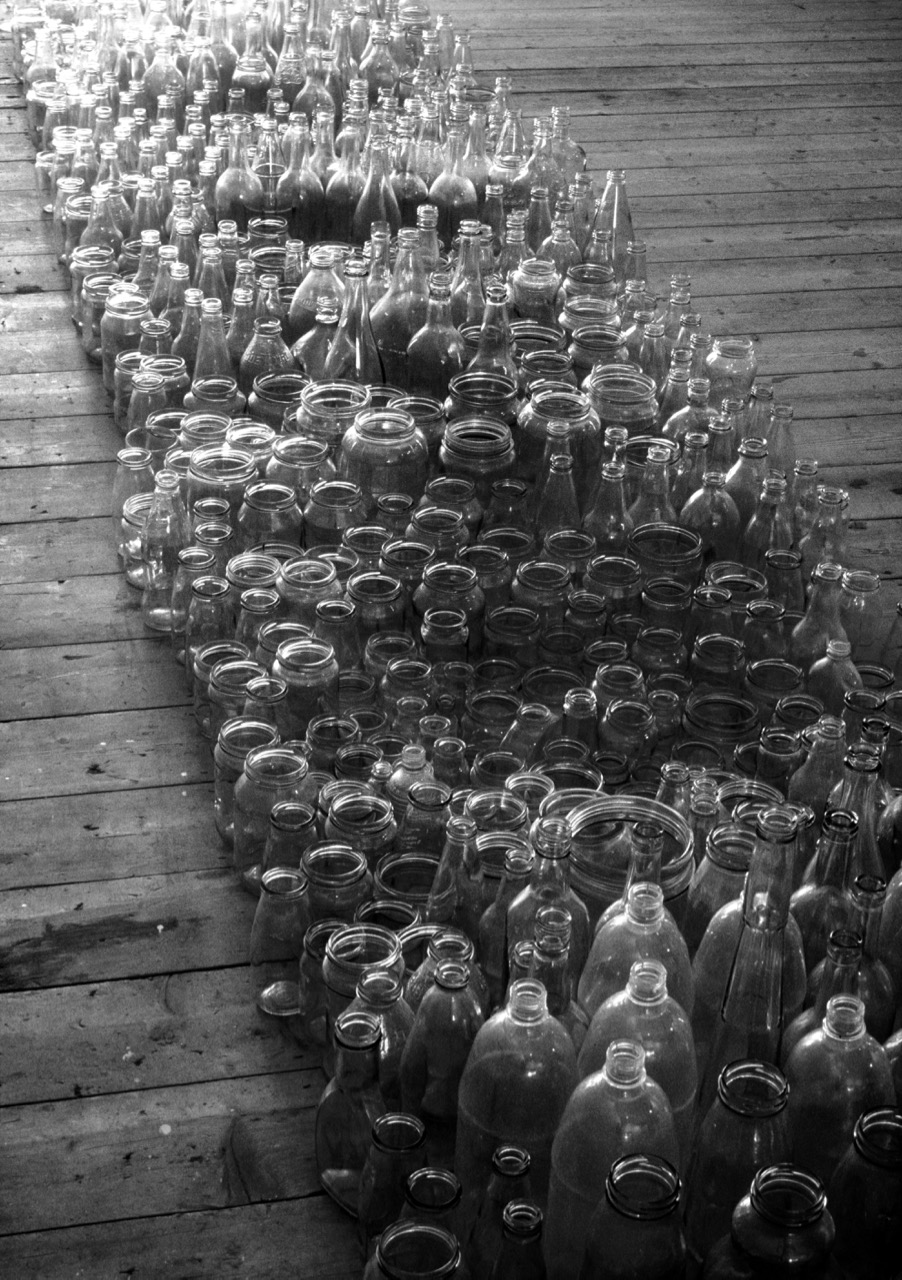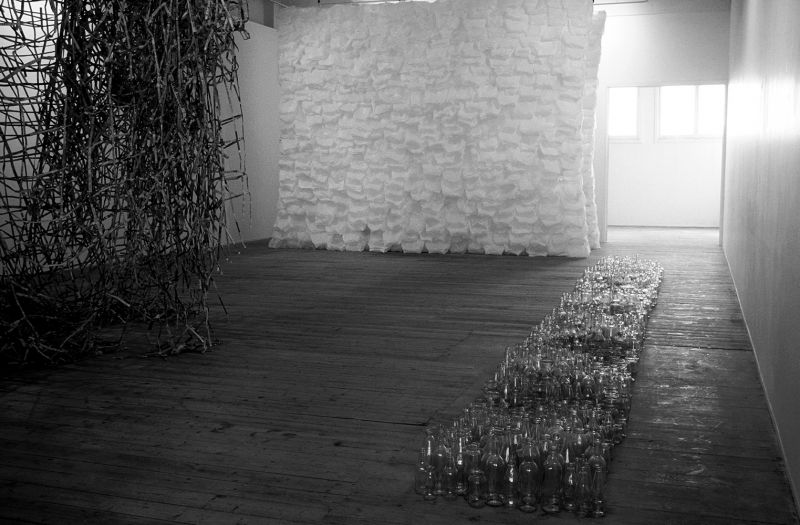Lauren Berkowitz: the artist as collector
Lauren Berkowitz, Bottles, 1994. Glass jars and bottles. 8D x 1Wm. Karyn Lovegrove Gallery, Melbourne. Photo: Steve Farrelly.
Get acquainted with the work of the acclaimed Australian installation artist and Victorian College of the Arts alumna ahead of her solo exhibition, Bottles, at the Margaret Lawrence Gallery.
By Rachel Kent, Chief Curator, Museum of Contemporary Art Australia
My art is one of retrieval, of natural and found materials that have poetic resonance. Lauren Berkowitz, 1994
The artist as collector has a long and rich history. For Australian artist Lauren Berkowitz, collecting is not only a driving force but an all-consuming passion, informing every aspect of her practice as it extends into her daily life and rituals.

For her solo exhibition at the Margaret Lawrence Gallery, Berkowitz has reinterpreted the installation Bottles from 1994. She does so in two new configurations, one circular and one linear, rethinking this seminal work’s intent and adding new layers of meaning.
Bottles was originally presented as part of a wider project, Bags, Bottles and Newspapers (1994) at Karyn Lovegrove Gallery, Melbourne. I remember this project well with its sinuous, winding column of clear glass bottles on the gallery’s wooden floor; its slumped grid of woven newspapers; and its soft, undulating wall of repurposed white plastic bags that swayed gently in response to visitors who passed by. Light yet dense, the works evoked a history of objects, consumption and personal meaning, from domestic and cleaning rituals to those of salvage and reinvention.
Reflecting on the artist’s practice over two decades, there is an evident trajectory that links early works such as Bottles with Berkowitz’s art today. Themes of collecting, recycling, cleansing and repurposing have been a mainstay of her art since her studies in the early 1990s in New York – a city overwhelmed by consumerism and its detritus. So too have ideas about repetition, accumulation, ordering and display.
There is a taxonomical imperative to much of Berkowitz’s art – of gathering and arranging like items into repeating configurations that highlight the materiality of the object and its relationship to space. Shifting beyond the structural, though, Berkowitz’s objects reveal the potential for transformation through art, and transcendence beyond the everyday. This is where the poetry lies – it can be found in the most commonplace item, quietly refigured in the hands of the artist.

Art historical precedents are also significant for Berkowitz. She has spoken about 1960s and ‘70s Minimalism and abstract art as particularly influential in relation to concepts of seriality, repetition and geometric form. Circles, spirals, grids and columns appear in Berkowitz’s assemblages of found objects. They extend further to her works of the 2000s, incorporating natural materials such as living or dried plants, soil, salt and coloured sands.
These later works extend themes of gathering and arrangement, albeit with growing, changing organisms in the case of her outdoor works and gardens. There is a generosity and abundance to Berkowitz’s works, with their multitude of objects. This plenitude is undercut by the pared back sensibility of Bottles – a proliferation of clean, colourless glass vessels that are devoid of their original contents.
The relationship between absence and presence has preoccupied philosophers and religious scholars for centuries. “Emptiness and fullness” is also a focus for Berkowitz’s work with its repurposing of glass bottles and jars, emptied and scrubbed clean. She collected the bottles over a six-month period, she recalls, and drew family members into the process as well. Some reflect the artist’s own consumer habits and include recycled bottles of olive oil, tomato puree, and jars of preserves.
Others – some many years old – came from the back of relatives’ cupboards and reflect the careful stocking and hoarding of items associated with post-war generations.

Speaking about this aspect of the work, Berkowitz cites the Fluxus artistic movement as significant with its incorporation of daily life as art. A further dimension – that of women’s work, domestic labour and cleaning rituals – is also meaningful; and Berkowitz cites the notion of “maintenance art” and the “unrecognised endless labour of daily care” as theorised by the American feminist artist Mierle Laderman Ukeles in her Manifesto for Maintenance Art 1969!. The fragility and instability of her materials, which are often undervalued and easily broken, adds yet another layer of meaning.
In her essay for Berkowitz’s 1994 exhibition, Natalie King acknowledged the personal and feminine narratives informing the artist’s transformation of waste-into-sculpture. Citing the delicate, suspended string, latex and fibreglass sculptures of Eva Hesse in particular, she drew parallels with Berkowitz’s approach to materials and form.
Aligning Berkowitz’s glass bottles with the hollow fibreglass cylinders of Hesse’s Repetition series from the late 1960s, King proposed: “The cycle of purchase and disposal is interrupted, intervened as a socially instrumental act. In both instances, the cylinders are lying prone as an expanse of undulating shapes and sizes”.
Interestingly, both artists share a Jewish heritage, something that Berkowitz has referenced in various works through symbolic materials. In the case of Bottles, it is alluded to through the ancient recuperative tradition of Tikkun Olam, or “world repair” through small acts and gestures.
Speaking about her presentation for the Margaret Lawrence Gallery, Berkowitz notes the relationship of the site to the history of water. The location of the gallery on a former swamp, the proximity of the Yarra River, and the history of flooding are all linked to the artist’s renewed presentation of Bottles.
In turn, they breathe new life and meaning into it.
This is an edited extract of the catalogue essay for Lauren Berkowitz: Bottles, which runs at the Margaret Lawrence Gallery, Melbourne, from 11 April–13 May, 2017. Visit the Margaret Lawrence Gallery website for more details.